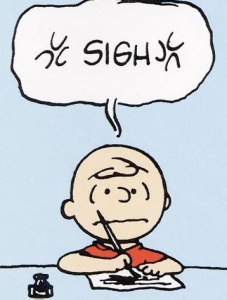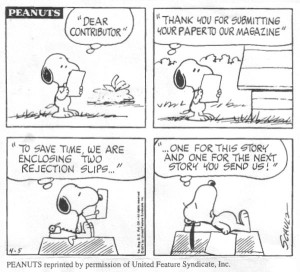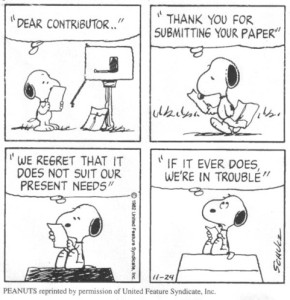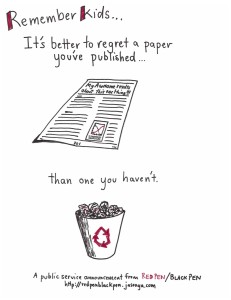When I raised a topic like this, I’m quite aware of your disappointment. It doesn’t make any sense at all to work on a paper that is intended to be thrown away. In fact, I’m on my way as you are to get my articles published instead of getting them rejected. However, after being rejected several times by several different journals and with different articles, I realized my potential to do it the other way. For some people, getting their articles published is a piece of waffle; for me, getting articles rejected is easier than preparing a herring. I was thinking that perhaps sharing the experience with you can help you to reflect your own experience if you have the unexpected experience of being rejected, or your own plan if you are planning to submit your article to a journal, and re-evaluate your own potential: whether you want to do it this way, or the other way?
I’m not alone in talking about how to get articles rejected. Some editors also did that. With exceptional expertise of themselves and profound sympathy to the authors of rejected articles, they got their articles on how to be rejected PUBLISHED on peer-reviewed journals. Personally, I do not recommend you to read these articles, because if you truly want to get your articles rejected, with their exhaustive advices (including very smart ones like “don’t put your photos in the paper,” which I should try next time), you might end up with your articles PUBLISHED. And that’s for sure.
Here’re my tips to get your article successfully REJECTED, seriously:
- Find an ideal group of readers
To get the article rejected is not as simple as you send your paper directly to a journal and wait to be rejected. It’s a time-consuming work requiring a lot of intelligence, strategy, energy, and patience. Sending blindly to a journal may face 90% of rejection, but our target is 100%. Therefore you need to make sure the readers of the journal would never, ever be interested or able to read such a topic as yours. The irrelevance can fall into two categories, the relevance of topic and the similarity of methods to the journal. You need to spend some time in searching for the most inappropriate journal. For example, when you find that 100% of the articles in the journal are based on empirical studies about language teachers, and you send them an article about a review of studies about students’ learning motivation, you’ll soon receive a notice of rejection. To be sure that the editors would hesitate and delay the notice for a moment, do not attempt to let them know any trace of possible, potential connection between your topic and the list themes of the journal or any article published there.
- Say things that people have already known
In order to get your article rejected, you need to write intentionally something readers already know. You can put a lot of weight in telling readers details about other studies in the field. Don’t tell your readers why you do these. Don’t waste your time to comparing them with your study. Don’t show anything they probably missed and might be dealt with by your study. No, never do that. You can raise your research questions that have been answered by other studies. Or, be smarter, raise an interesting question but end up with findings anyone can imagine from common sense. You are successful if you read your own manuscript and find it just a redundant piece for any journal or any reader.
- Don’t let your reader know your purpose
Of course you know your purpose of study and article very well. That’s why it’s not fair to you to let your readers know it so easily. Some editors would suggest you to hide your purpose of study and research questions somewhere in the paper. My suggestions is never, ever write any statement suggesting the purpose of your study. Write in a way of a Chinese Zen Buddhist, tell your story, and keep the readers guessing, meditating, and bewildered. If they begin to doubt themselves and have illusion, they know what to do with your paper.
- Say things that are not of any use
Not every journal wants very practical articles like how to teach an elephant to dance. Some journals want articles to tell readers how it is possible to (know how to) teach it. As an author wants your article to be rejected, you need to ignore both. You don’t have to avoid mentioning any use of your study. An easier way is that you stick tightly to your data and results, and repeat them time and again in discussion and conclusion. If the reviewers cannot understand what they can see from your study, they’ll kindly reject the paper.
- Terrify your readers by your expertise
As a professional researcher, you need to show your expertise by terrifying your readers how much terms and related knowledge you know or you can imagine. Don’t give them explanations of any term you use, even at the first time. Shock them by your expertise by change the terms about the same thing frequently, without any explanation also. You have to believe that your readers are professionals and able to use google or wiki to check out things they don’t know. If they are tired of looking the terms up for two days to read your article, they will pick up another one or another journal, which gives a reason for the editor to reject your article. Is that reasonable?
- Trust your English or your proofreader
If you’re non-native speaker of English, you stand more chance to be rejected. Don’t believe the lies of the editors in public conferences that they don’t have bias against non-native speakers. They are talking to authors whose English is precise and perfect, not everyone. Try sending out a draft without checking the spelling or grammar, and you’ll find out how biased they are. If you think a proofreader can prevent you to be rejected, you’re mistaken again. Please trust them and let them do whatever they want to do with your paper, and if they like, they can also send it out directly to the journal. You’ll see how fast it is rejected. Most proofreaders focus on the correctness of the language. They are, mostly likely, not the experts in your field. So, if you want a paper with perfect language and probably nonsense at some (important) places of your paper, never discuss with them or correct anything. The trust will earn you another rejected paper.
- Ignore the format or trivial details to you
For an author with trust in your expertise, you don’t have to sacrifice your dignity for a formatted publication. Simply get rejected by sticking to your own way of writing in whatever English and whatever format. If the editors think it not healthy to their readers and themselves because they have to think hard for the structure of your paper, or search everywhere for a clear note or reference, they can simply reject it. You can ignore any author instruction the journal provides. If the editors ask you to check your format after submission, just ignore it.
- Never write to editors
Some time you get a sad surprising message from the editors which says you can revise your paper and resubmit to their journal. Of course you can revise the paper according to their suggestion if you like, but never send any email to the editor in resubmission to explain what you have done. If they don’t know whether you have revised it according to their suggestion, they can reject it. In another case, if you are irritated by the obvious wrongful judgment of your article, don’t waste your time to complain. Just go for another journal.
Last suggestion and very much the least, don’t read the two articles I’ve mentioned. I listed the information of the articles here. So if you by any chance see them, just ignore them:
Hagger, M. S. (2012). How to get your article rejected. Stress Health, 28(4), 265-268. doi: 10.1002/smi.2458
Linton, J. D. (2012). How to get your papers rejected (or not). Technovation, 32(1), 6-8. doi: 10.1016/j.technovation.2011.09.006
Though I share with you the experience of getting papers rejected, it doesn’t mean I won’t be happy for you if you get papers accepted. Please share with me your experience of getting papers published, which, I’m sure, will be more constructive than the advices above.












Berkembang dari semangat inovasi, Universitas Ciputra adalah tempat yang menawarkan pendidikan berkualitas tinggi dengan fokus pada kreativitas dan kewirausahaan.
What a fun blog, Dadi 🙂 So actually, this is “what not to do” if you do want your article to get published. Though it would be fun to see what your article would end up like if you implemented all these rules 😛
Thanks for the comment. Frankly speaking, I did try some of these rules in my former submission, and realized my mistakes from the feedback of the reviewers and supervisors. For example, the rule of hiding your argument, I think it’s rooted in my culture that we tend to imagine that readers can read our minds, and with my background of literature study, I easily drowned myself and the readers in the vast ocean of details. So now I keep asking myself questions like “what are you talking about?”, “what do you mean by this?”, “why should I know about all these?” It’s painful, but quite worthwhile, to keep challenging yourself from the perspective of a reader and rewrite again and again until he/she is satisfied.
Hi Dadi,
I really enjoyed your blog. As I am at the moment working on writing my first paper, it is very useful to read what I should do if I want it to be sent to the trash. And thus, what NOT to do if I want it to be published 😉
Thank you!
Thank you very much for the comment. I’m glad it’s useful to you. Of course the article was meant for the opposite direction. In a teasing way I also reflected what I’ve done. One thing behind all these is: though we all understand there might not be a perfect research, but everyone expects a perfect article. So, we can never be too satisfied with the draft, can we? 😉